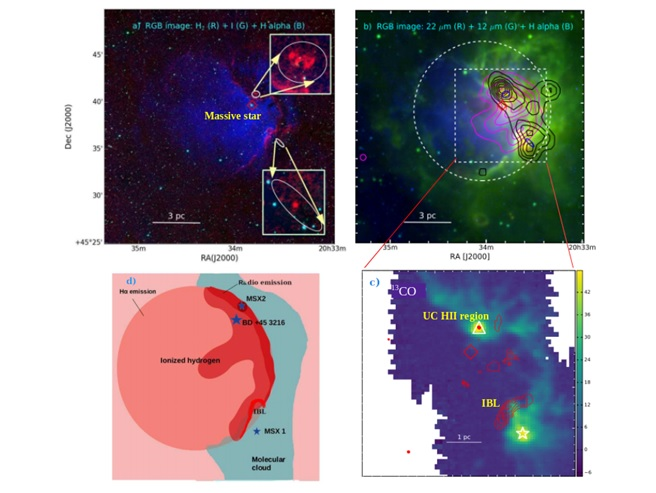
Scientists have investigated how massive stars trigger the formation of second-generation stars (stars molded from remnants of first-generation star formation activity) in HII regions --- emission nebulae created when young, massive stars ionise nearby gas clouds with high-energy UV radiation. This can help trace the formation of massive stars at much younger stage.
For a long, scientists have explored the possibility of inducing star formation in the environment of HII regions. Though several models have been proposed, it is still not clear if triggering is important in all star-forming regions (SFRs) and which triggering mode is efficient.
Astronomers at Aryabhatta Research Institute of Observational Sciences (ARIES) Nainital, an autonomous institute under the Department of Science & Technology (DST), Government of India, along with their collaborators from the Tata Institute of Fundamental Research, Mumbai; Physical Research Laboratory, Ahmedabad; Kavli Institute of Astronomy & Astrophysics, Beijing and Indian Institute of Astrophysics, Bangalore, studying an HII region, called Sh2-112 found that the nebula and its environment created by a massive star 23 times more massive than our Sun, triggered the formation of second-generation stars at the periphery.
This study, which has been accepted for publication in the 'Astrophysical Journal', was conducted using Devasthal Fast Optical Telescope ARIES, 2-m Himalayan Chandra Telescope, Giant Metre-wave Radio Telescope (GMRT), and so on.
The researchers found evidence for the interaction of the HII region with the left-over cloud material (from first-generation stars), triggering the formation of the next generation of stars for the first time.
The scientists observed a census of the young stellar and proto-stellar candidates populated toward the western boundary of the HII region. A young (compact/ultra-compact) HII region formed due to a star about 15 times more massive than the Sun was also found in that direction.
Figure 1: (a) An optical/infrared view of the Sh2-112 region. H2 emission (in red color) traces the boundary between the ionized and molecular gas and/or outflow from young stars. (b) Distribution of the heated dust (red and green) color and ionized gas (blue color) in the Sh2-112 region. The magenta contours show the distribution of the ionized gas obtained from GMRT data. The black contours represent the surface density distribution of the young stars. c) Distribution of the molecular gas, as well as the locations of compact HII region and young massive stars in the region, are shown. d) Cartoon diagram representing the morphology of the HII region Sh2-112.
Publication link:
Arxiv link: https://arxiv.org/abs/2010.11065
For more details, Neelam Panwar (neelam[at]aries[dot]res[dot]in), ARIES, Nainital can be contacted.






























